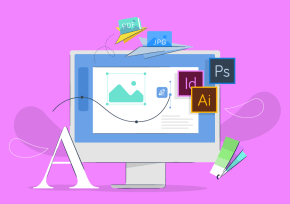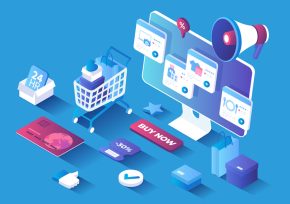In the dynamic landscape of today’s business world, where first impressions are everything and visual appeal reigns supreme, the role of graphics design cannot be overstated. Graphics design serves as a powerful tool that goes beyond aesthetics; it’s a strategic approach that can significantly boost businesses. From creating a memorable brand identity to enhancing user experience, graphics design plays a pivotal role in shaping a company’s success.
1. The Power of Visual Communication
In a world inundated with information, capturing the attention of potential customers is a formidable challenge. This is where graphics design steps in. Through captivating images, infographics, and visually appealing content, businesses can convey complex messages quickly and effectively. Humans are inherently drawn to visual stimuli, making it easier for brands to communicate their value proposition and leave a lasting impact.

2. Establishing a Strong Brand Identity
A distinctive brand identity is a cornerstone of any successful business. Graphics design plays a key role in creating logos, color schemes, and overall visual elements that define a brand. Consistency in these elements not only fosters brand recognition but also builds trust and loyalty among customers. Think of iconic logos like the golden arches of McDonald’s or the swoosh of Nike – these symbols have become synonymous with their respective brands.
3. Enhancing User Experience (UX)
In the digital realm, user experience is a critical factor that can make or break a business. Graphics design directly impacts the way users interact with websites, applications, and other digital platforms. Intuitive navigation, visually pleasing layouts, and attention-grabbing call-to-action buttons are all aspects of UX design that contribute to a seamless and enjoyable user journey.

4. Conveying Professionalism and Credibility
Imagine visiting a website with pixelated images and mismatched fonts – it’s hardly an inspiring sight. On the other hand, a well-designed website exudes professionalism and credibility. Quality graphics design gives businesses an edge by showcasing their dedication to providing top-notch products and services. It’s a silent yet persuasive way of assuring potential customers that they’re dealing with a reputable company.
5. Storytelling through Visuals
Every business has a story to tell, and graphics design provides the canvas for that narrative. Compelling visuals can evoke emotions, convey values, and transport customers into the brand’s world. Through carefully crafted images and graphics, businesses can create a connection that transcends mere transactions, fostering a sense of belonging and resonance.
6. Versatility in Marketing Materials
Graphics design isn’t limited to just digital platforms; it extends to various marketing materials as well. From business cards and brochures to banners and social media posts, well-designed visuals can make these materials stand out in a crowded market. Consistency in design across different mediums reinforces brand recognition and reinforces the overall messaging.

7. Adapting to Trends and Innovations
The field of graphics design is constantly evolving, with new trends and technologies emerging regularly. Embracing these innovations allows businesses to stay relevant and appealing to their target audience. Whether it’s incorporating augmented reality elements or adopting minimalist design principles, staying updated in graphics design can give businesses a competitive edge.
8. Engaging Social Media Presence
In the age of social media, visuals dominate users’ feeds. Eye-catching graphics, shareable infographics, and visually appealing videos have the potential to go viral and reach a massive audience. Businesses that invest in creative graphics design for their social media platforms can increase their reach, engagement, and ultimately, their conversions.
9. Making Information Digestible
Complex data and information can be overwhelming when presented in a text-heavy format. Graphics design simplifies this process by transforming intricate details into easily digestible visuals. Whether it’s in the form of charts, graphs, or diagrams, businesses can present information in a way that is both comprehensible and engaging.
10. A Competitive Edge in Advertising
In the fiercely competitive business landscape, advertising is a battleground where attention is the prize. An advertisement with striking visuals is more likely to capture attention amidst the noise. Graphics design enhances the effectiveness of advertising campaigns, helping businesses communicate their message with impact and flair.

Graphics design
Graphic design is a creative process that involves combining visual elements such as images, typography, colors, and layout to convey a message or communicate an idea effectively. Whether you’re designing for print materials, digital platforms, branding, or any other purpose.
Conclusion
Graphics design is a potent tool that goes beyond aesthetics, shaping businesses and their success in multifaceted ways. From establishing a strong brand identity to enhancing user experience and conveying professionalism, its impact is far-reaching and undeniable. In a world where visual communication reigns supreme, harnessing the power of graphics design is no longer a luxury but a necessity.
FAQs
Q1: How does graphics design contribute to increasing brand recognition?
A1: Graphics design plays a pivotal role in brand recognition by creating visually distinctive elements such as logos, color schemes, and visual identity. Consistent and memorable design helps customers identify and remember your brand easily.
Q2: Can graphics design effectively enhance user experience on websites and digital platforms?
A2: Absolutely. Graphics design improves user experience by creating visually appealing and user-friendly interfaces. Intuitive navigation, pleasing layouts, and engaging visuals contribute to a seamless digital journey.
Q3: What role does graphics design play in the realm of social media marketing?
A3: Graphics design is a driving force in social media marketing. Eye-catching visuals, shareable content, and visually appealing posts help businesses stand out, increase engagement, and broaden their social media reach.
Q4: How often should businesses consider updating their brand’s visual elements to stay relevant?
A4: While there’s no fixed timeline, businesses should consider updating visual elements periodically to align with evolving trends and audience preferences. Regular updates show adaptability and a commitment to staying current.
Q5: Can graphics design serve as a valuable tool for conveying intricate and complex information in a clear manner?
A5: Absolutely. Graphics design simplifies complex information through visuals like charts, graphs, and infographics. This enhances understanding, making data more digestible and engaging for the audience.











